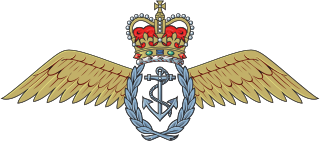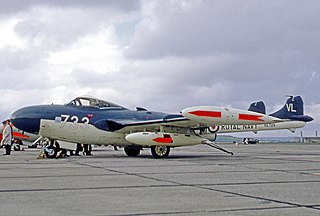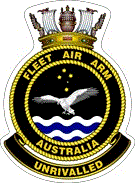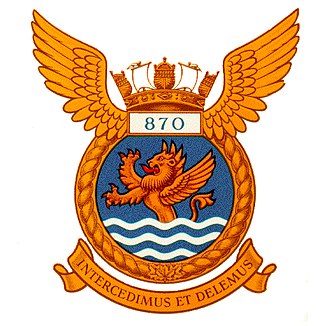
The Fleet Air Arm (FAA) is the naval aviation component of the United Kingdom's Royal Navy (RN). The FAA is one of five RN fighting arms. As of 2023 it is a predominantly "rotary" force, with helicopters undertaking roles once performed by biplanes such as the Fairey Swordfish. It operates the F-35 Lightning II for maritime strike and the AW159 Wildcat and AW101 Merlin for commando and anti-submarine warfare.

The de Havilland Sea Venom is a British postwar carrier-capable jet aircraft developed from the de Havilland Venom. It served with the Royal Navy Fleet Air Arm and with the Royal Australian Navy. The French Navy operated the Aquilon, developed from the Sea Venom FAW.20, built under licence by SNCASE (Sud-Est).

The Fairey Gannet is a carrier-borne aircraft that was designed and produced by the British aircraft manufacturer the Fairey Aviation Company. It was developed for the Royal Navy, being the first fixed-wing aircraft to combine both the search and strike portions of anti-submarine warfare (ASW) operations to be operated by the Fleet Air Arm (FAA).

Royal Naval Air Station Lee-on-Solent,, is a former Royal Naval Air Station located near Lee-on-the-Solent in Hampshire, approximately 4 miles (6.44 km) west of Portsmouth, on the coast of the Solent.

Kirkwall Airport is the main airport serving Orkney in Scotland. It is located 2.5 NM southeast of Kirkwall and is owned by Highlands and Islands Airports Limited. The airport is used by Loganair.

The Fleet Air Arm (FAA), known formerly as the Australian Navy Aviation Group, is the division of the Royal Australian Navy (RAN) responsible for the operation of aircraft. The FAA was founded in 1947 following the purchase of two aircraft carriers from the Royal Navy. FAA personnel fought in the Korean War and the Vietnam War, and participated in later conflicts and operations from host warships.

HMAS Albatross is the main naval air station for the Royal Australian Navy's (RAN) aviation branch, the Fleet Air Arm. The base, located near Nowra, New South Wales, was formally established in May 1942 as Royal Australian Air Force (RAAF) base RAAF Nowra, then was transferred to the Royal Navy as HMS Nabbington in 1944, and operated as a naval air station until it was decommissioned in late 1945. In 1948, the airfield was commissioned into the RAN as HMAS Albatross, as the primary shore base for the Fleet Air Arm. Since 2011, five squadrons of the Fleet Air Arm operate from Albatross. The current commander of the base is Captain Robyn Phillips, RAN.

The Percival Prince is a British light transport of the early postwar period. It was a twin-engine, high-wing, cantilever monoplane of all-metal stressed-skin construction; the undercarriage was of retractable, tricycle type.

Naval Air Station Squantum was an active naval aviation facility during 1917 and from 1923 until 1953. The original civilian airfield that preceded it, the Harvard Aviation Field, dates back to 1910. The base was sited on Squantum Point in the city of Quincy, Massachusetts. It also abutted Dorchester Bay, Quincy Bay, and the Neponset River.

808 Naval Air Squadron is a ship-based helicopter squadron of the Royal Australian Navy.

1700 Naval Air Squadron of the Fleet Air Arm of the Royal Navy was formed in November 1944 at RNAS Lee-on-Solent as an amphibian bomber reconnaissance squadron. It was equipped with the Supermarine Sea Otter, and the squadron joined HMS Khedive in January 1945 bound for Sulur in India. On arrival the Sea Otters were augmented with Supermarine Walrus amphibian aircraft.
893 Naval Air Squadron was a Naval Air Squadron of the Royal Navy's Fleet Air Arm.
734 Naval Air Squadron was a Naval Air Squadron of the Royal Navy's Fleet Air Arm. It was active between 1944 and 1946, formed as a naval Engine Handling Unit. Initially operating out of RNAS Worthy Down, it subsequently relocated to RNAS Peplow, where it eventually disbanded.

751 Naval Air Squadron was a Naval Air Squadron of the Royal Navy's Fleet Air Arm. It was initially active as an Observer Training Squadron from 1939 to 1944 as part of No.1 Observer School. 751 NAS formed at RNAS Ford in May 1939. Ford was attacked and bombed, in August 1940, and the following day the squadron relocated to RNAS Arbroath. Twelve months later it moved to RNAS Dundee, remaining there until disbanding at Dundee in May 1944.
1840 Naval Air Squadron was a Naval Air Squadron of the Royal Navy's Fleet Air Arm. During World War II over 80% of the pilots were from the Royal Netherlands Naval Aviation Service.
1843 Naval Air Squadron was a Naval Air Squadron of the Royal Navy's Fleet Air Arm.

860 Naval Air Squadron was a Naval Air Squadron of the Royal Navy's Fleet Air Arm during World War II, which was transferred to the Royal Netherlands Navy in 1946, and remains active.
861 Naval Air Squadron was a Naval Air Squadron of the Royal Navy's Fleet Air Arm.

870 Naval Air Squadron, also known as VF-870, was a squadron of the Royal Canadian Navy (RCN). It was formed when 803 Naval Air Squadron of the Royal Navy was renumbered to 870 NAS on 1 May 1951. It operated throughout the 1950s and early 1960s before disbanding on 7 September 1962. It was the first RCN squadron to operate jet aircraft.













